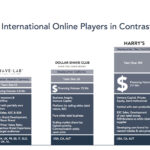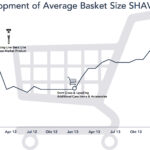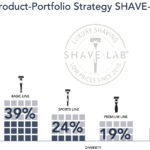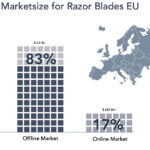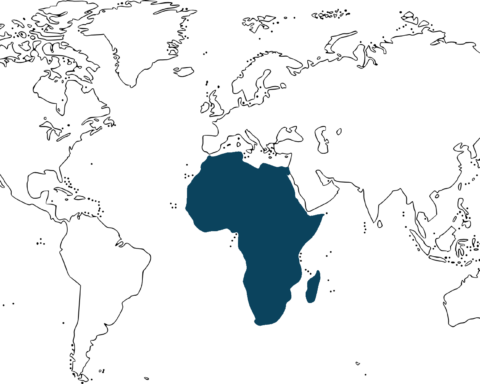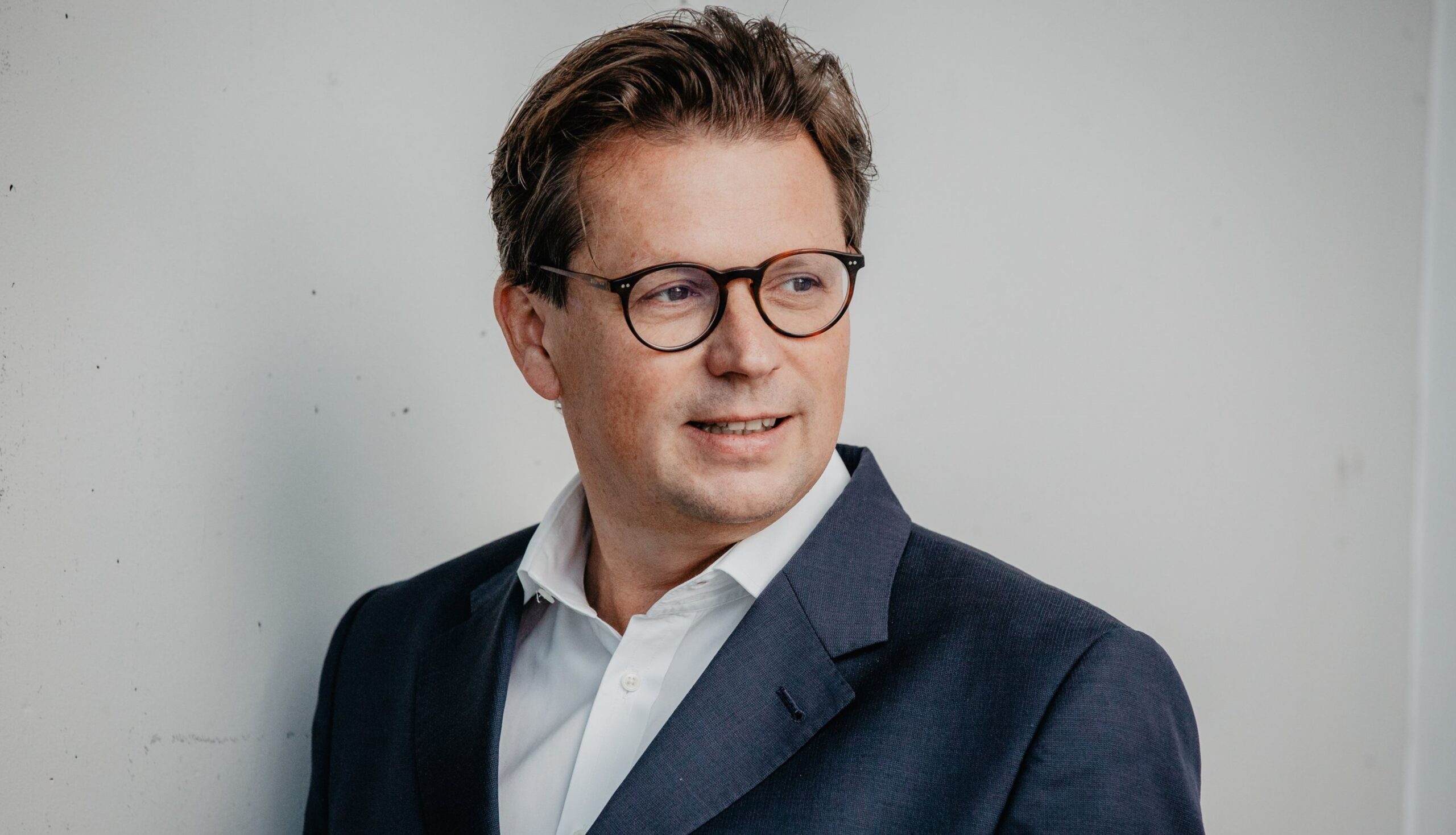Business ideas often occur at the same time in the digital economy. And that is not a coincidence. Even if you start with comparable conceptual designs – when in competition, companies tend to differ: through strategy, values and identity.
It is hard to believe, but changeable razorblades are one of the most stolen items in drugstores and supermarkets. The demand is high, changeable razorblades are expensive: depending on the number of the built-in sharpened steel plates, they cost between 2.50 and 6 Euros per item. This price range has been stable for decades – and this despite production costs being around the cent mark.
The razor market follows own traditions and rules. It is dominated by the market leaders Gillette and Wilkinson. Both together hold around 85 percent of the turnover achieved with wet shave razors. In 2013 this amounted to 13 billion US Dollars worldwide, whilst Europe’s share amounted to 2.5 billions, and Germany 950 million Dollars.
A huge market volume, few competition, solidified structures: this attracts founders. After Shave-Lab, which started in autumn 2011, another dozen start-ups appeared in Europe and in the USA, which were built on the same business model: the online sale of changeable razor blades with matching handles.
Now, three or four international companies have managed to establish themselves in addition to Shave-Lab, such as Big Moustache in France and Razwar in Belgium. In the USA, Dollar Shave Club and Harry’s are also pursuing the same conceptual design. Harry’s in New York – the last one founded in the online industry in 2013 – received a lot of attention in 2014, when it bought the 94-year-old producer Feintechnik in Thuringia for around 100 million Dollars with the help of financers. Investors also regard the razor-market as lucrative, to the extent that they are financing start-ups by investing hundreds of millions.
There are three theses in regards to the razor market, which I would like to elaborate on:
- Creativity and genius are underestimated in regards to founding: (business) ideas are the result of market analyses and not flashes of wit.
- There are no “equal” businesses. Even our copycats are different from the original: because they were founded by other personalities, their aims are influenced by this, which in turn develops an autarkic identity.
- Innovation should be a part of all company areas, but is often only linked to offers.
Business ideas need to ripen
When it comes to art, Pablo Picasso is regarded as an undoubted genius. When looking at his work, one can see that the genius of his work actually consists of exercise and an analytic feel for presence and art. Picasso was able to depict a bull in a few lines, as he had drawn the same motive dozens, if not hundreds of times. The idea to portrait a person, such as “Dora Maar” from two perspectives, was not a flash of wit, but stemmed from his focus on abstraction, as well as on works by Georges Braque, Paul Klee and others.
Economy business ideas also do not come to life over night, even the disruptive ones. Just as with art, they reflect current demand. Conceptual designs continue to develop throughout their realisation. And this requires persistence, but also the willingness to question experience and to quickly adjust strategies to customer demand and markets.
Jeff Bezos did not invent e-commerce, but extended the online sale of books by additional products and therefore created a successive market, which offers technical services to sellers. Larry Page and Sergeij Brin reduced the advertisement-sponsored search concepts of Yahoo, Altavista or Lycos and managed to create a different advertisement format whilst searching for sources of income; advertisements next to search results. Uber combines mobile technology with the willingness to share and consequently constructs applications for city and supplier traffic.
The digital economy is limitless and draws on the acceleration of information and communication. New business regularly pop up at the same time. One example for this is the online sale of wet shave razors: even though we at Shave-Lab are able to claim the first mover title and were the first to offer such services – many of our competitors followed within a few months, so they must have worked on it at the same time. We are the agitator – we created the movement in this specific industry.
I suspect that many innovative foundations are being inspired by Nespresso these days. Nespresso is one of the case studies for innovation often quoted at universities and during consultations, as it demonstrates how a re-thinking of habits can reform a market and enable new business: the idea to offer coffee in capsules or portion units was first developed in the 1970s. It is only through a collaboration with producers, such as Krups, Miele, DeLonghi and others, that a system was developed, which has been on sale since the 1990s and which completely changed the coffee tradition.
Market signals for change
Business ideas are also developed as a direct result of the frustrations and experiences of the founders. But most of them stem from systematic analyses of the functioning of markets, clients and their requirements. In order to find their Nespresso, the founders looked for industries with a low level of competition, finished products and high prices. The razor market offered such signals. I found it in 2004 and spent several years changing an everyday product into a lifestyle item. These indicators were encouraging:
- A specialised market consisting of producers and traders.
- Product innovations are introduced under high advertisement pressure. Gillette released the “fusion” razor with five blades in 2006 and booked a 90 second transmission during the Super Bowl for its release – one of the most expensive advertisement environments of the world – and is thought to have paid 7.5 million Dollars for this.
- The product has been greatly developed. Replacement blades consist of sharp steel plates, which are surrounded with rubber in a plastic case. Innovations are limited to sharpness technology and the addition of blades, but they require a high level of development effort. This degree of maturity in regards to the production makes it difficult for new parties to enter the market.
- Little competition: Next to the market leaders, a handful of competitors produce no name blades, mostly on behalf of trade enterprises and drugstore chains.
- Solidified distribution structures: Drugstores and supermarkets are not tied to one supplier and offer all brands in little presentation space, as well as being able to earn a high margin with the products – this also enables them to offer cheaper own brands.
From the analysis to the plan
Sharper, more moveable and less harsh on the skin: these were the criteria for Gillette’s and Wilkinson’s innovative efforts and advertisements. Customer demand is obviously also a focus, but engineering art and know-how took precedence. The producers proudly advertise their high-tech products and the essential research that is being carried out for this purpose. No competitor would be able to challenge this – unless they invest millions.
The distribution, on the other hand, was different, as the producers did not appear to develop it any further, as they were relying on their partners. But the growing reach of the internet and the increasing level of connections between machines allowed for new distribution channels, new chances for production and a broad experimental field for innovations, which needed to be claimed. Especially when considering that the usual distribution channels – stationary trade – are no longer reliable and that market shares are moving over to e-commerce. The gaps left by the producers in regards to dealing with the internet, are currently being filled by start-ups. They saw an opportunity in the area of wet shave razors
- to vertically expand a market, which had been specialised so far,
- to develop new forms of distribution, such as subscriptions for razorblades or new product packages,
- to involve customers in the production and offer design through mass-customisation or personalisation and
- to reach customers in a new and more personal manner, and to deal with criticism directly and openly. It is nothing else than changing product attributes + dealing with customers.
Of the dozen companies, which started in 2012, those remained, who were able to adjust the idea and the implementation plan to the reality of the business, and who were able to develop their own identity. Being attacked by the Lilliputians very much affected the people of Goliath. Of the 2.5 billion US dollars of turnover, which is achieved in Europe with changeable razor blades, 17 percent or 425 million Dollars were already earned through online sales in 2014. Gillette is currently trying to open their own distribution channel via a mobile online ordering system in order to strengthen their network.
Differences developed through strategies
Even though we are all building on a similar business, the websites already show differences: most of our competitors are appealing to men, and not to women at all. Shave-Lab, on the other hand, has developed an offer for both men and women in the meantime. From an optical and content point of view, Harry’s is aiming at urban lifestyle enthusiasts or adventurers, Big Moustache or Razwar are targeting their offers towards trendy, but also price-sensitive young men. Shave-Lab focuses on culture and style in connection with attractive prices – and without discounting in regards to communication – and on top offers a choice of six unisex holders in different colours, as well as blades and beauty products.
On second glance, the conceptual designs differ in regards to their vertical approach degree. After purchasing Feintechnik, Harry’s holds a complete value. Today, the New York start-up employs more than 400 workers and also produces blades for stationary trade customers, as well as the Harry’s blades. The vertical approach degree at Shave-Lab is around 80 percent: the blades are developed together with a partner and are being produced exclusively. For the handles and accessories, we have invested in machines and have established a production line with our partners in China. This allows us to produce our own designs and to meet our high quality expectations. The other competitors purchase handles and blades from different partners, which are not being manufactured on an exclusive basis and which may also be traded by other brands.
The list of differences could be continued, the US companies were financed with two or three figure million sums, the Europeans had to make do with lesser amounts. These examples alone show: it is the targets and the strategies, which make business incomparable. With the help of investors, which have financed more than 200 million Dollars, as well as the additional purchase since 2013, Harry’s is competing against the duopoly Gillette and Wilkinson. The chance of the new against what has already been established lies in the linkage of the internet competencies, which are still being developed by Gillette and Wilkinson, as well as in bought, technical blade know-how. Dollar Shave Club in the USA are aiming at the price leadership, whilst offering the comfort of a subscription for an everyday product at the same time. The Europeans and Mornin’ Glory – another German follower – are pursuing a similar strategy. But the Berlin start-up did not consider their German customers: they do not like to commit to subscriptions, even if it offers comfort and cheaper prices. Mornin’ Gory now also focuses on the development of a beauty brand in addition to the razor business, and aims to introduce them for stationary trade.
Values provide companies with a face
More so than the strategy, the founders’ signatures help to ensure an autarkic appearance. Identity is developed through their values, wishes and perspectives. The development of Shave-Lab is characterised by the desire to develop a uniform brand and business, which is able to compete and grow. We aim to achieve a high two figure million sum in regards to turnover until 2018 and would like to employ 20 to 30 employees. In order to realise this plan, we not only sell razors, but also stile, design and joie de vivre.
This can be seen in all of our offerings: blades and grips are being present in specifically designed carton packaging. Customers can create the grips according to their taste. Similar to Hennes & Mauritz, Mercedes or magazine publishers, we offer our products in different price ranges and series. H&M is the best example: good design at democratic prices. If you like to treat yourself to a little bit of luxury, you can find purist elegant designs at Shave-Lab, and if you are more of a pragmatic thinker, you can access the colourful, cost-effective basic line. But irrespective of what the customers are buying, they will stay in the same shop and will be able to experience one brand. We are offering a uniform customer journey without “discrimination.” The name Shave-Lab will not be diluted through the extension of product series.
Judging by our expectations, we will never be the cheapest on the market, but that is also not what we want: price design has an ethical component. Our blade prices will continue to be far below those of Gillette or Wilkinson, but we will not give up organically grown partnerships in exchange for saving a few pennies, or reduce salaries in order to be more efficient. “Repeat purchases” by loyal customers are not solely made on a price basis. It depends on the overall market experience. Such expectations did not appeal to venture capital lenders, as they only look at figures and demand quick growth, no matter at what price. We were able to raise 3 million Dollars from own funds and with the help of an entrepreneur financer in order to develop Shave-Lab. The investors are also looking at the figures, but they also advise us in many matters – they are thinking long-term. Exit drivers often are not sustainable. The whole “founder industry” is suffering from exactly this illness. Shave-Lab has managed to achieve profitability in regards to its operational business, today we are delivering to 22 countries and continue to expand via licensing and franchising partners. By distribution to business clients in the hotel & airline industry, Shave-Lab was able to open another distribution channel.
It never goes to plan
It can be assumed that competitors have made similar experiences: some ideas had to be adjusted to reality in retrospect. Before starting, we developed 16 products in one year, but we achieved the sale
s targets much later than planned. The development of tight processes and the outsourcing of tasks were not deemed to be efficient for some areas: online traders should develop own competencies in regards to shop design, search engine optimisation and marketing. But the last years have shown that the internet has created a new market for wet shave razors, which may grow, and which has cost the duopoly market shares. Founders are benefiting from this, but most importantly, customers also benefit: they have more choice, and the purchase is more fun. But whether this will reduce the theft rate of razors at drugstores remains to be seen.


